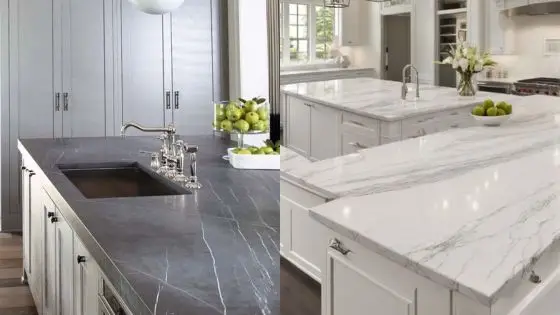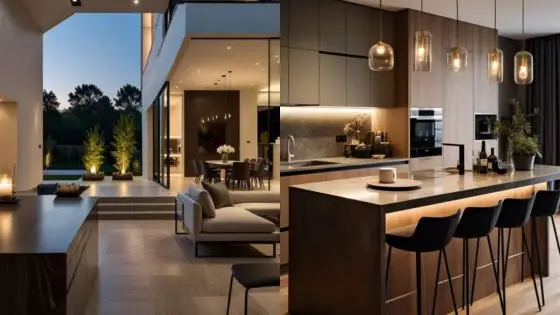Transforming your kitchen with the right tiles can elevate both its style and functionality. From stunning backsplashes that serve as focal points to durable flooring options that withstand heavy traffic, tiles offer versatility that few other materials can match. Whether you prefer natural stone for a luxurious feel, wood-look tiles for warmth, or bold ceramic patterns for personality, your choice of kitchen tiles will define the space’s character for years to come.
As we move through 2025, kitchen tile trends continue to evolve, with subway tiles maintaining their timeless appeal while Zellige tiles and marble-inspired looks gain popularity. The beauty of kitchen tile design lies in its ability to blend aesthetics with practicality—creating surfaces that resist stains and moisture while adding visual interest. You can mix textures, colors, and patterns to create a custom look that reflects your personal style.
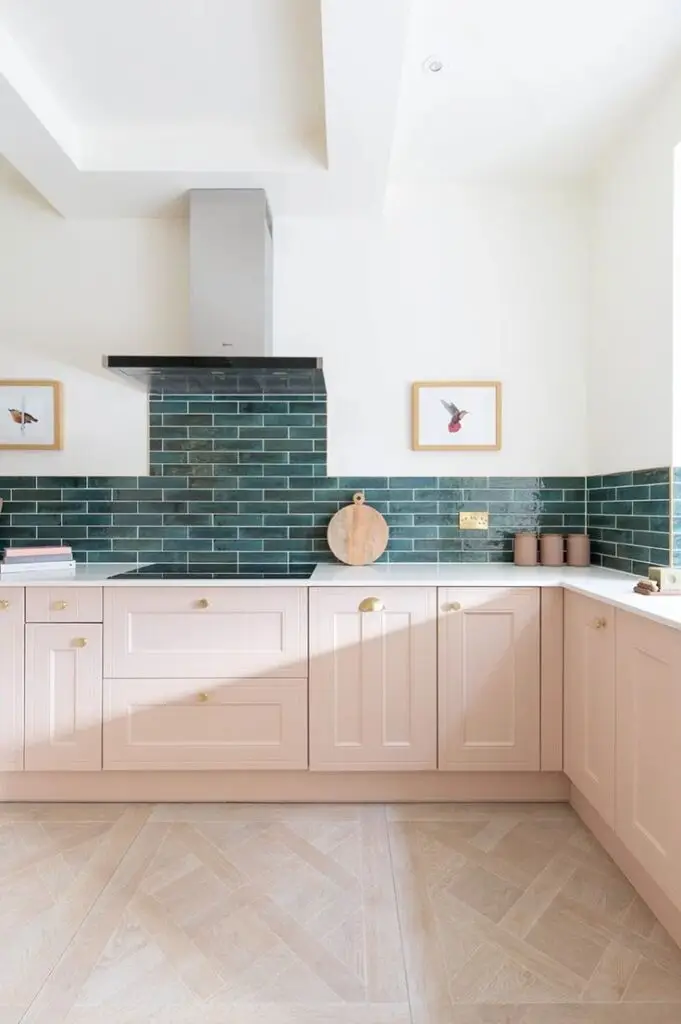
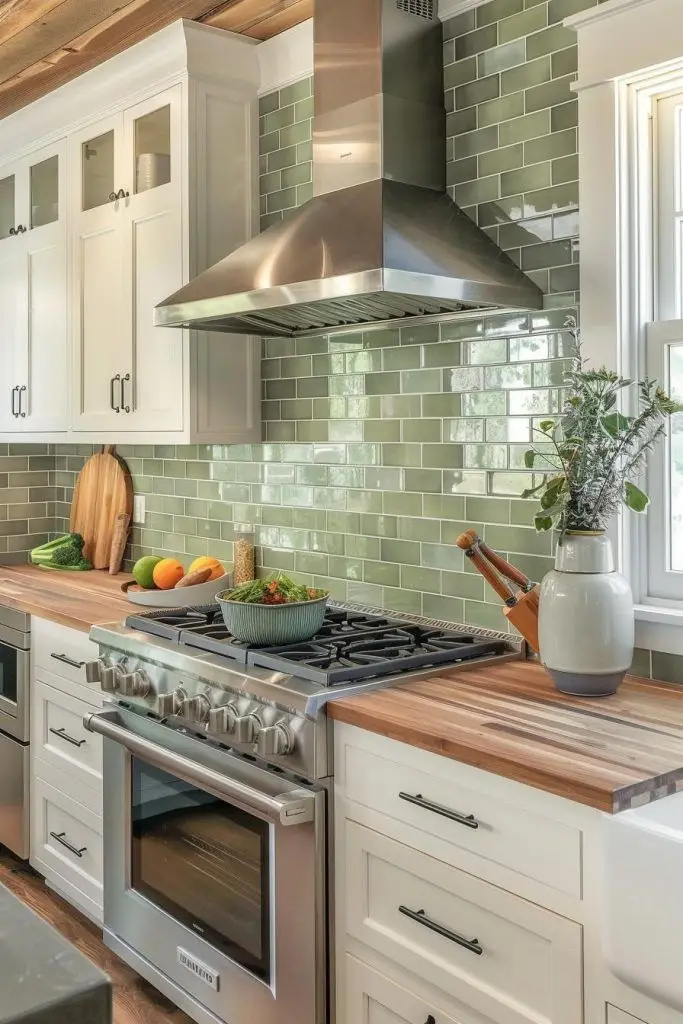
Key Takeaways
- Kitchen tiles come in various materials including ceramic, porcelain, and natural stone, each offering different benefits for durability, maintenance, and visual appeal.
- Your tile selection should balance aesthetic considerations like color and pattern with practical needs such as slip resistance for flooring and stain resistance for backsplashes.
- Professional installation ensures longevity, though many tile options are designed with DIY-friendly features to help you achieve a high-end look at various price points.
Choosing the Right Material
Material selection significantly impacts the functionality, durability, and aesthetic appeal of your kitchen tiles. The right choice depends on where the tiles will be installed and how your kitchen is used.
Porcelain Versus Ceramic
Porcelain tiles offer superior durability for kitchen floors, making them ideal for high-traffic areas. They’re denser and less porous than ceramic options, resulting in better water resistance and fewer maintenance concerns.
Porcelain typically costs $2-15 per square foot, depending on quality and design complexity. These tiles can withstand heavy foot traffic and resist scratches effectively.
Ceramic tiles provide a more budget-friendly alternative at $2-8 per square foot. They’re easier to cut and install yourself, potentially reducing installation costs.
For kitchen floors, opt for tiles with a slip-resistance rating appropriate for wet areas. Textured finishes provide better traction when spills occur.
Both materials come in endless styles, colors, and patterns, but porcelain offers superior performance for heavy-duty kitchen environments.
Natural Stone Options
Natural stone tiles bring organic beauty and uniqueness to your kitchen. Each piece has distinct patterns and color variations that manufactured tiles cannot replicate.
Popular natural stone options:
- Slate: Non-porous and naturally slip-resistant
- Granite: Extremely durable with distinctive flecking
- Marble: Elegant but requires regular sealing
- Travertine: Warm tones with natural pitting
Stone requires more maintenance than manufactured tiles. Most varieties need regular sealing to prevent staining and water damage, particularly around food preparation areas.
Costs range widely from $5-100 per square foot depending on the stone type, quality, and rarity. Installation also tends to be more expensive due to the material’s weight and cutting complexity.
For busy kitchens, harder stones like granite or slate offer better durability than softer options like marble or limestone.
Glass Tiles and Their Appeal
Glass tiles introduce luminosity and depth to kitchen spaces, particularly as backsplashes where they can reflect light beautifully. Their non-porous surface resists stains and bacteria, making them exceptionally easy to clean.
These tiles come in countless colors, finishes, and transparency levels. Iridescent and metallic options create stunning visual effects as lighting conditions change throughout the day.
While glass works wonderfully for vertical surfaces, it’s not ideal for floors due to potential slipperiness and lower impact resistance. Installation requires precision as cutting mistakes are often visible.
Glass tiles typically cost $7-30 per square foot. Their reflective properties can make smaller kitchens appear more spacious and brighter.
Consider combining glass with other materials in a mosaic pattern for visual interest without overwhelming the space. Small glass accent tiles can add vibrant pops of color to more neutral surroundings.
Terracotta and Terrazzo
Terracotta tiles bring warmth and rustic charm to kitchen spaces. These clay-based tiles develop a beautiful patina over time, adding character to your kitchen. They require regular sealing to prevent staining and moisture absorption.
Typical costs range from $5-15 per square foot. Installation should include proper sealing to maintain their appearance and durability.
Terrazzo offers a different aesthetic altogether, combining chips of marble, quartz, glass, or other materials in a cementitious or resin base. This creates a distinctive speckled appearance that works beautifully in contemporary kitchens.
Modern terrazzo tiles cost $15-30 per square foot but provide exceptional durability. Their seamless appearance makes them particularly appealing for larger floor areas.
Both materials connect to design traditions while remaining relevant in contemporary settings. Terrazzo offers better water resistance for busy kitchens, while terracotta creates an inviting, warm atmosphere.
Innovative Encaustic Tiles
Encaustic tiles feature designs created with different colored clays rather than surface glazes. This construction means patterns remain intact even as the tile wears, making them surprisingly durable for high-use areas.
These tiles typically cost $15-30 per square foot but make a dramatic visual impact. Their intricate patterns can serve as a stunning focal point in kitchen designs.
Traditional encaustic tiles use cement, while modern versions often incorporate porcelain for improved performance. Both options provide excellent durability when properly maintained.
Consider using encaustic tiles as a feature section rather than throughout the entire kitchen. Their bold patterns work well in defined areas like kitchen islands or as a decorative border.
Regular sealing helps preserve their appearance, particularly in food preparation areas. With proper care, these distinctive tiles can maintain their beauty for decades.


Aesthetic Considerations
The visual impact of kitchen tiles extends far beyond mere functionality. Thoughtful selection of tile colors, patterns, sizes, and placement can transform an ordinary kitchen into a personalized culinary sanctuary that reflects your unique style.
Color Palettes and Schemes
White tiles remain a perennial favorite for creating bright, clean kitchen spaces that visually expand the room. You can pair white tiles with contrasting grout for subtle texture or use them as a neutral backdrop for colorful accents elsewhere.
Blue tiles bring a calming influence to busy kitchens, ranging from soft duck-egg tones to bold navy options. Consider blue subway tiles for a classic yet contemporary look.
Green has surged in popularity for 2025, offering natural freshness. From sage to emerald, green tiles connect your kitchen to the outdoors.
Beige and neutral tiles provide timeless warmth without overwhelming the space. These versatile options complement both modern and traditional cabinetry.
For bold statements, black tiles create dramatic contrast, while pink tiles inject playful personality into contemporary designs.
Decorative Patterns and Shapes
Herringbone arrangements transform simple rectangular tiles into dynamic visual elements. This classic pattern adds movement and sophistication to backsplashes without requiring decorative tiles.
Hexagon tiles have maintained their strong presence in 2025 kitchen designs. You can create subtle or dramatic effects depending on your color choices and installation pattern.
Decorative tiles with intricate designs serve as artistic focal points. Use these sparingly for maximum impact—perhaps as a border or accent within a simpler tile arrangement.
Geometric patterns offer contemporary appeal, whether through the tiles themselves or their arrangement. Consider mixing solid-colored tiles in alternating patterns for a custom look.
Hand-painted or artisanal tiles add unique character that mass-produced options cannot match. Even a small section of specialty tiles can elevate your entire kitchen design.
Creating a Feature Wall
A tile feature wall creates a stunning focal point in your kitchen. Select a prominent area—behind the stove or sink—for maximum visibility and practical protection.
Bold patterns or vibrant colors work beautifully for feature walls. You might choose dramatic Zellige tiles with their characteristic handcrafted variations and glossy finish for an elegant statement.
Contrast is key to successful feature walls. If your kitchen primarily features neutral tones, a richly colored tile feature will draw the eye and anchor the space.
Patterned tiles make excellent feature wall materials. You can use encaustic-style tiles with their bold geometric designs or delicate floral motifs depending on your kitchen’s overall aesthetic.
Consider extending your feature wall from countertop to ceiling for a dramatic architectural element that defines your kitchen’s character.
The Impact of Tile Size
Small format tiles (1-3 inches) create texture-rich surfaces with multiple grout lines that add visual interest. These petite tiles work particularly well in vintage-inspired kitchens or as mosaic accents.
Medium rectangular tiles, like the classic subway format, offer versatility through various arrangement patterns. You can install them horizontally, vertically, or in herringbone patterns for different effects.
Large format tiles (12+ inches) minimize grout lines for a sleek, contemporary appearance. These substantial tiles make small kitchens appear larger and create clean, uninterrupted surfaces.
The scale relationship between your kitchen size and tile dimensions matters significantly. In compact kitchens, oversized tiles can provide simplicity, while expansive kitchens can accommodate more intricate small-scale patterns without becoming visually cluttered.


Functional Spaces
Tiles transform ordinary spaces into functional areas that withstand daily demands while maintaining aesthetic appeal. The right tile choices can significantly enhance durability, cleanliness, and visual impact in high-traffic or moisture-prone areas of your home.
Tiles for the Bathroom and Shower
Bathroom tiles need to balance beauty with practicality in a moisture-rich environment. For shower floors, small mosaic tiles (1-2 inches) provide superior slip resistance due to the numerous grout lines creating natural traction.
Porcelain tiles offer exceptional water resistance with absorption rates below 0.5%, making them ideal for shower walls and bathroom floors. They require minimal maintenance while resisting stains and moisture damage.
Consider large-format tiles (12×24 inches or larger) for bathroom walls to reduce grout lines and create a more seamless appearance. This minimizes cleaning efforts and creates a visually expansive effect in smaller bathrooms.
For a spa-like atmosphere, natural stone tiles like marble or travertine add luxury, though they require regular sealing to prevent water damage. Textured tiles with matte finishes offer better slip resistance than polished surfaces.
Kitchen Backsplash and Flooring
Kitchen backsplashes serve dual purposes: protecting walls from splashes while acting as design focal points. Subway tiles remain popular for their timeless appeal and easy cleaning properties.
Glass tiles reflect light beautifully, enhancing brightness in kitchens with limited natural light. Their non-porous surface resists stains and bacterial growth, making them hygienic choices for food preparation areas.
For kitchen floors, porcelain and ceramic tiles offer outstanding durability against dropped utensils and heavy foot traffic. Look for tiles with a PEI rating of 4 or 5 to ensure they can withstand kitchen demands.
Recommended Kitchen Tile Characteristics:
- Slip-resistant texture for safety
- Stain-resistant surface for easy cleanup
- Color variation to disguise crumbs and minor spills
- Compatible with underfloor heating for comfort
Outdoor Tile Solutions
Outdoor tiles must withstand extreme weather conditions while maintaining appearance and safety. Frost-resistant porcelain tiles prevent cracking during freeze-thaw cycles, making them excellent choices for patios and walkways.
For pool surrounds, look for tiles specifically rated for outdoor wet areas with slip-resistance values (R10-R12). Textured natural stone or porcelain tiles provide secure footing while complementing your landscape design.
Outdoor mosaics can create stunning decorative features on vertical surfaces away from direct foot traffic. Use frost-proof adhesives and grouts designed for exterior applications to ensure longevity.
Consider through-body porcelain tiles for outdoor spaces, as their color runs throughout the tile rather than just on the surface. This makes chips or scratches less visible over time and extends the visual lifespan of your installation.

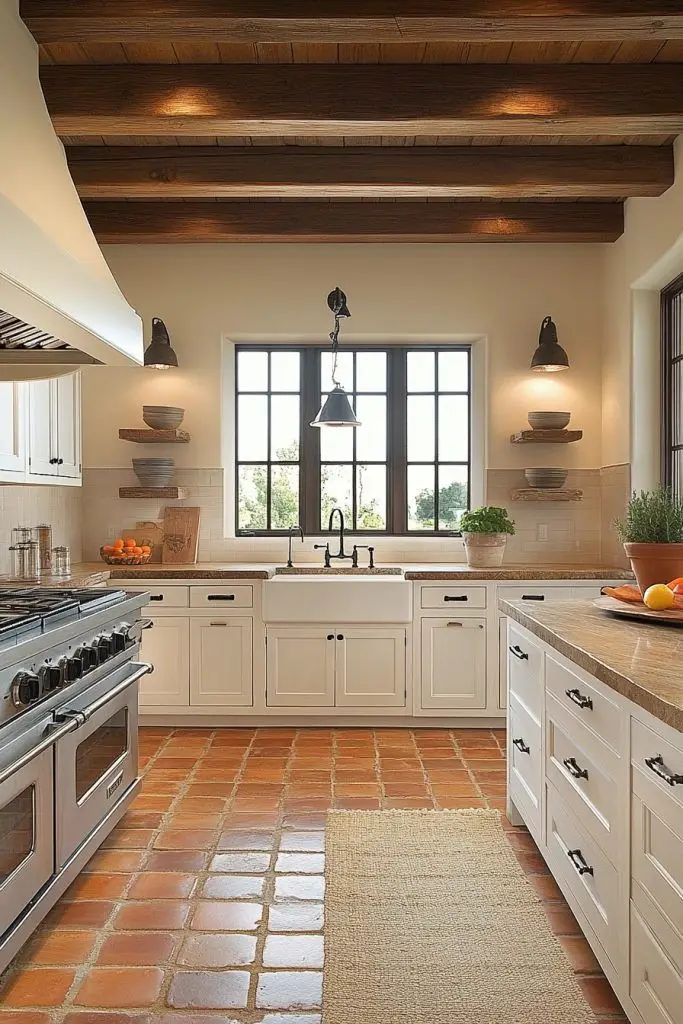
Installation and Maintenance
Proper installation and regular maintenance ensure your kitchen tiles remain beautiful and functional for years to come. The right techniques during installation and appropriate care afterward can dramatically extend the life of your tile investment.
Professional Installation Tips
When installing kitchen tiles, always begin with a level surface. Use a laser level to ensure your first row is perfectly straight, as this will affect the entire installation. For backsplashes, start at the bottom and work your way up, maintaining consistent spacing with tile spacers.
If you’re deciding between installing tiles before or after cabinets, professionals often recommend tiling first. While this requires more materials, it creates a cleaner finish and makes future cabinet replacements easier.
For diagonal patterns, measure carefully from the center of the wall outward. This technique not only creates visual interest but also makes your kitchen appear larger, as mentioned in Curbio’s design tips.
Remember to allow proper drying time between laying tiles and grouting. Usually 24-48 hours is sufficient, depending on your adhesive manufacturer’s recommendations.
Easy Care and Cleaning
Ceramic and porcelain tiles are popular kitchen choices partly because they’re incredibly easy to maintain. For daily cleaning, simply wipe with warm water and mild soap using a soft cloth or mop.
Avoid abrasive cleaners that might scratch the surface, especially with glossy tiles. For stubborn stains on porcelain tiles, a paste of baking soda and water works effectively without damaging the finish.
Grout lines require special attention as they tend to collect dirt and can discolor over time. Clean them regularly with a soft brush and specialized grout cleaner.
Consider applying a penetrating sealer to grout lines every 1-2 years. This prevents moisture absorption and staining, particularly important behind sinks and cooking areas.
Wipe up spills immediately, especially acidic substances like tomato sauce or citrus juice that can etch into natural stone tiles.
Repair and Longevity
Most quality kitchen tiles, particularly porcelain, can last 50+ years with proper care. Their durability makes them an excellent long-term investment for busy kitchens.
If a tile cracks, address the issue promptly to prevent water damage to the substrate. Always keep a few extra tiles from your original batch for repairs, as finding exact matches later can be challenging.
For minor chips in ceramic tiles, touch-up glaze kits can restore the appearance without full replacement. Porcelain tiles, being denser, are less prone to chipping but more difficult to repair when damaged.
Check grout lines periodically for cracks or deterioration. Regrouting may be necessary every 10-15 years depending on kitchen usage and the quality of the original installation.
Consider using darker grout in high-traffic cooking areas as it shows less wear and staining over time, maintaining a fresher appearance between deep cleanings.
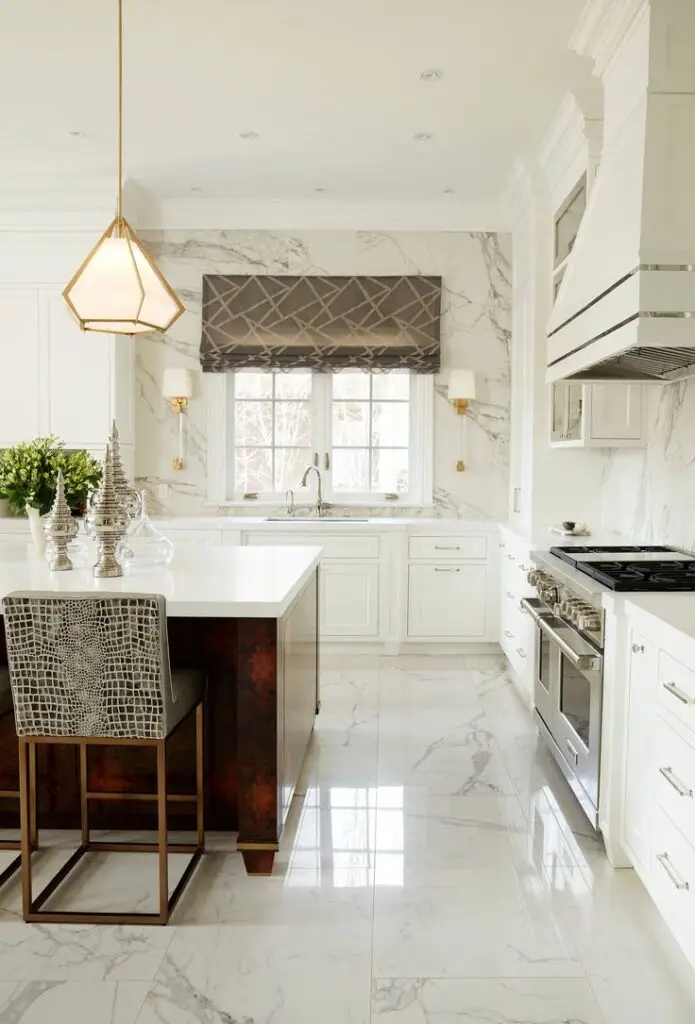
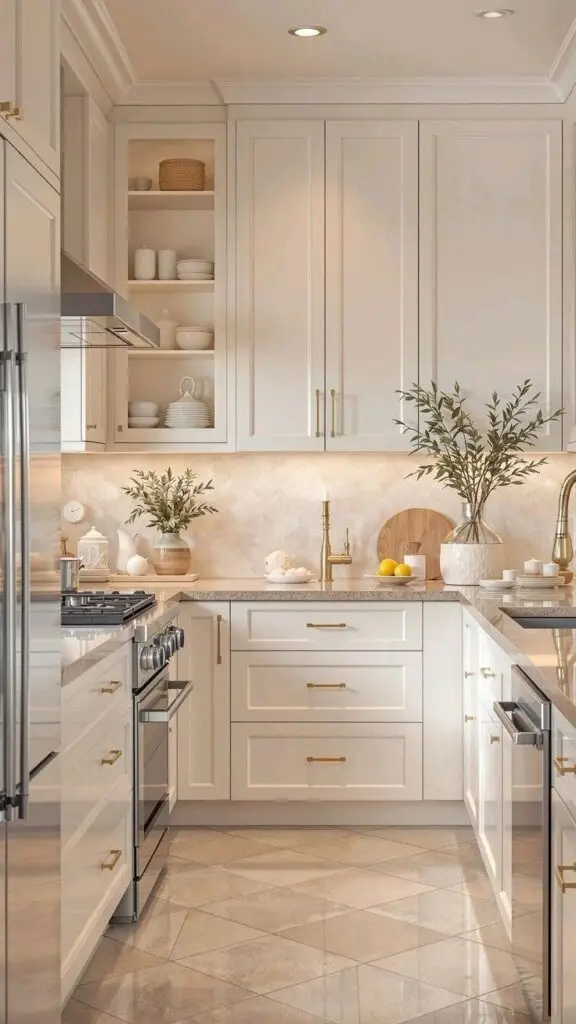
Shopping Guide
Finding the perfect kitchen tiles involves more than just picking a style you love. You’ll need to navigate stores, evaluate samples, and understand the relationship between quality and cost to make a smart investment that enhances your space.
Navigating Tile Stores and Suppliers
Start your search at specialty tile shops where knowledgeable staff can guide you through options suited to your kitchen’s specific needs. Home improvement centers offer convenience and often feature popular trends mentioned in 2025 forecasts, like subway tiles and Zellige options. Consider visiting showrooms to see tiles installed in full kitchen displays, giving you a better sense of how they work with fixtures and furniture.
Online retailers provide extensive selections and often offer virtual visualization tools. Check for availability before finalizing your design plan, as some specialty tiles may have extended lead times. Many suppliers offer discounts when purchasing in bulk, so calculate your square footage carefully.
Pro Tip: Ask about discontinued tiles or overstock for potential savings, but always buy extra for future repairs.
Tile Sampling and Visualizing
Request samples of your top choices before committing. Most suppliers offer sample programs for a small fee, often refundable with purchase. Bring these samples home to see how they look under your kitchen’s specific lighting conditions throughout the day.
Place samples against your cabinetry, countertops, and alongside existing fixtures to ensure color harmony. Some retailers now offer augmented reality apps that let you visualize tiles in your space before purchasing.
Create a mood board combining your tile samples with paint chips, cabinet materials, and photos of your furniture and fixtures. This comprehensive approach helps prevent costly design mistakes.
Sample Strategy: Arrange multiple samples in the pattern you plan to install them, including grout lines, to get an accurate preview of the finished look.
Evaluating Quality and Price
Price variations often reflect durability differences rather than just aesthetics. Porcelain typically costs more than ceramic but offers superior water resistance—crucial near sinks and cooking areas. Check tile ratings for hardness and water absorption to ensure suitability for your kitchen’s traffic and moisture levels.
Factor in installation costs when budgeting—intricate patterns or specialty tiles often require more skill and time to install. Ask about sale cycles; many suppliers offer seasonal discounts that can significantly reduce costs.
Calculate the total project cost including:
- Tiles (plus 10-15% extra for cuts and potential future repairs)
- Adhesive and grout
- Specialized tools if DIY installing
- Professional installation if required
Remember that investing in quality tile often pays off in longevity and continued appeal, particularly with timeless styles highlighted in 2025 kitchen trends.
- 1share
- Facebook0
- Pinterest1
- Twitter0


